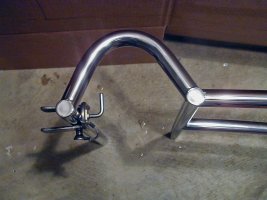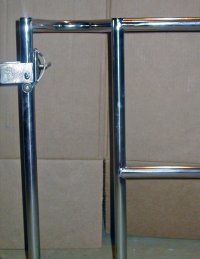Now we're talking!
Ted,
OK-keep in mid these are settings for the J boat. Since nobody cares if your J measurement is spot on (under IMS/IRC the J can change as you move the mast in the partners-all the way forward and your J gets a bit smaller-as will your headsails since the LP is a function of J-and your rating)-For now, leave it where it is, and I would leave the step alone, too, until you see the new main. Yes, use the main halyard as you describe (plumbob for rake, main halyard for bend). Do NOT even mess with the fwd and aft lowers until you see the new main-unless you know how much luff curve they are putting in.
My advice is the set the rake at about an inch-then measure the headstay and note this value (we'll come back to this later).
Go sailing with the new main. With a loose backstay and the lowers as you have had them (assuming you liked the way the mast behaved), the main should be quite full. Then go to about 80% of max backstay. If all is set up correctly, the main should be BOARD FLAT-even a wrinkle going from the clew to the mast is OK (called an inversion wrikle because the sail is "inside out"). If you can't get the sail this flat at 80% of max backstay, start by adding prebend by easing the aft lowers about 1.5" and taking up on the fwd lowers the same amount-see what happens. If still not enough do it again until you have induced about 1.5 " of prebend. If that won't get you flat with the 80% BS, the next step is to move the mast AFT in the step. If after doing all this you still cannot get the main board flat, the main may simply be too full (I would guess you are seeing about 8-9" total bend at this max setting). If they have used more than 8-10" of luff curve you may have trouble getting it flat enough and need a recut.... BUT...I highly doubt they will use more than 5-6" (what I would use as long as I have a hyd adjuster).
So, while those are the steps, I doubt you will need to go very far in the process.
Apart from all of this, there IS an element in the rake equation where the fwd most step setting will help incude more aft rake, and the aft most will do the opposite. I have not mentioned this becasue most of the 38 types (a normal cruiser racer mentality) will not be as consumed with rake, and simply using a HS length is plenty sophisticated for club racing!
Once you have that magic HS length for the base setting (lets play with the 1" number for now), it is simple matter of increasing the HS length if you find you have too neutral a helm in light-moderate air and/or are not happy with your pointing. Keep dropping it back until you get the right combination of performance and feel (you should take up or let off an equal amount on the little turnbuckle that comes with the Hyd backstay adjuster when you make the HS adjustments so that the adjuster still has the same effect on HS sag). All you are doing is moving the top of the mast fwd or aft-which is changing......tada: RAKE!!!!

And if you do as I suggest, you will still get the same amount of bend with the backstay-regardless of what amount of RAKE you are carrying. If you want to really get optimal, establish HS lengths for 0-5, 6-12, and 12+ knots of wind. Write them down, and "season to taste" on race day-it will help.
When going downhill, be sure and let the BS ALL the way off (to get rid of as much aft rake (and hence weather helm) as you can. When I said in a previous post BS does not affect rake-I meant in the sense of upwind/reaching/controlling mainsail shape. If you let it all the way off while going downwind, the tip will of course go fwd. You might also take the Genny halyard down to the jib tack fitting and grind it snug to get the slack out of the backstay (and put lots of slack in the HS). This will get the mast as far fwd as you can-noticeably faster when going downhill. This is a big advantage of in-line spreader boats as opposed to swept aft types like the 36.7, J 30, etc. because on those boats the upper shrouds control the HS tension to a large degree, and you can't easily back those off when going downhill in a buoy race!! In-line spreader boats, frac or masthead, can have the top of the mast move as needed to add or reduce helm.
In case this part was not clear, a fwd raked mast helps dowwind speed as much as an aft rake helps upwind speed-the idea is to give the boat a bit of "help" (a little weather helm will point higher, and a little lee helm helps you dig deeper).
We are getting pretty deep in the performance angle, but it is good stuff!!
Let me know how the main fits!
Seth




